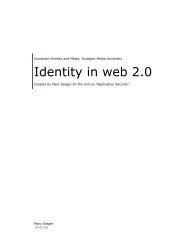The current state of anonymous file-sharing - Marc's Blog
The current state of anonymous file-sharing - Marc's Blog
The current state of anonymous file-sharing - Marc's Blog
Create successful ePaper yourself
Turn your PDF publications into a flip-book with our unique Google optimized e-Paper software.
a certain throughput/security trade<strong>of</strong>f, it extremely extends the amount and availability<br />
<strong>of</strong> <strong>file</strong>s. Both, search queries and results are only forwarded between trusted peers. <strong>The</strong><br />
"<strong>of</strong>ficial" implementation <strong>of</strong> turtle hopping, which was developed at the Vrije Universiteit<br />
in Amsterdam also uses encryption between hops to keep eavesdroppers from listening<br />
to the searches.<br />
A great source <strong>of</strong> further information concerning the darknet pattern is "<strong>The</strong> Darknet<br />
and the Future <strong>of</strong> Content Distribution" by Micros<strong>of</strong>t [9]<br />
5.2 <strong>The</strong> Brightnet pattern<br />
<strong>The</strong> word Brightnet makes one thing pretty clear: it’s the opposite <strong>of</strong> a Darknet. To<br />
freshen up you memories: In the Darknet pattern, you only control WHO you share<br />
your data with, but once you decide to share with a peer, you usually don’t have any<br />
secrets from that node about WHAT you share.<br />
In the Brightnet pattern it is exactly the opposite: you usually don’t care that much<br />
about who you trade data with, but the data itself is a "secret".<br />
This might seem a little bit confusing, how can data that is openly shared with everyone<br />
be a secret?<br />
To understand this, one has to look at the typical bits and bytes that are shared in a<br />
<strong>file</strong>-<strong>sharing</strong> application: Usually, every piece <strong>of</strong> data does not only consists <strong>of</strong> arbitrary<br />
numbers, but it has a certain meaning. It is part <strong>of</strong> the movie "xyz", the song "abc"<br />
or the book "123". When uploading even a small portion <strong>of</strong> this data, you might be<br />
infringing copyright or, depending where you live, might get yourself into all sorts <strong>of</strong><br />
trouble for the content you downloaded. This could lead to the situation that every<br />
government agency or corporation could tell if you’re <strong>sharing</strong>/acquiring a <strong>file</strong> by either<br />
simply receiving a request from or sending a request to you (given that you’re on an<br />
"open" network) or looking at the transfered data on an ISP level.<br />
<strong>The</strong> main idea behind the brightnet pattern is to strip the meaning from the data<br />
you transfer. Without any distinct meaning, the data itself isn’t protected by any<br />
copyright law or deemed questionable in any way. It would be totally fine to share<br />
and download this meaningless data. To end up with "meaningless" data, the <strong>current</strong><br />
brightnet implementations use a method called "multi-use encoding" as described in the<br />
paper "On copyrightable numbers with an application to the Gesetzklageproblem[19] by<br />
"Cracker Jack" (<strong>The</strong> title is a play on Turing’s "On computable numbers").<br />
<strong>The</strong> simplified idea is to rip apart two or more <strong>file</strong>s and use an XOR algorithm to<br />
recombine them to a new blob <strong>of</strong> binary data which, depending on the way you look at<br />
31



